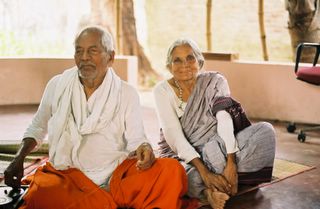Roots (D. Willis)
Anyway, what did my taxi driver friend think of the tsunami? "Ah, I’m fed up with the tsunami," he said, "Too much news about it, la." "Yeah, I said, there has been a lot of news." And then, after some silence he said, "Do you know what was most amazing about the tsunami?" I started to answer, but he immediately spoke, taking the words from my mouth:
"What was most amazing about the tsunami? It was that everybody in the world got it. They all understood what it was about, that we needed to come together, that this affected all of us. And people’s generosity was so great. No more fighting, no more using the military for that. Instead they are where they can really help. And are helping."
For me, this linkage, the bonds like these between people, really began appearing in my landscape when I went to India in 1970. My first visit to Tamil Nadu was in late December of that year, when I arrived after a four-month trek overland from Europe, through the Middle East, Iran, Afghanistan, Pakistan, and Northern India. The epic nature of this journey only gradually began to dawn on me during those travels. It was a different era and a different kind of travel, more adventure than tour. We did not know where we were going or staying. There was almost no road map other than word of mouth, which there was a lot of, and certainly no Lonely Planet travel guide. And it was not always very safe. But something was calling me, maybe my pioneer Quaker roots, maybe my ancestors way back wandering on the savannah.
My great-great grandfather Harvey had walked to California from the East Coast. The year was 1849. He found gold. A friend who traveled with him wrote ‘Guide to the Goldfields’ so we know about this, and then Harvey came back to Iowa to found a town with his brother John named Perry (not, thank god, Willisville, which they had first thought of, though the main street still is Willis Avenue). They had been dissenting Quakers, their ancestors going first to Nantucket from England (the New England whaling families, including my relatives the Macy’s, were all Quakers), then the mountains of Tennessee and North Carolina, where they founded the Lost Creek Meeting, the first religious body in the South calling for immediate manumission of all slaves. Soon after we find them in Richmond, Indiana, the atmosphere having become a little "hot", I imagine, in the South. So, my pioneer roots are there, I guess, at least partly what compelled me to search and discover new worlds. Only this time it was new worlds in old worlds.
During my life in an Indian village outside of Madurai called Naraynapuram, village of the primeval cosmic man, I met many remarkable people, among them my brother J. Rajasekaran, who will be traveling to LAFTI with me next weekend. And I found my career, anthropology and later education, a love of the life and diversity of peoples. So that is what I do. Being an anthropologist, an educator, and someone who does cultural studies (more an English than the North American approach) has been rewarding and challenging. Working for nearly twenty years in a Japanese Buddhist university in Osaka, I have not been able to forget my other roots in South India.
Three of the most remarkable people I have ever met were Dick Keithan, Krishnammal, and Jagannathan. Keithanji had been an American missionary who had worked with Mahatma Gandhi and was thrown out of his mission for this revolutionary activity. He became an Indian citizen and walked the walk, and talked the talk, with the Gandhians, becoming one himself along with his friends Krishnammal and Jagannathan. I met Dick in Kodaikanal in 1976, where I had gone to teach in a mission school in the process of becoming international. He and I spent hours in his bungalow up on the road to Pillar Rocks talking about social change and the Gandhian movement. Of course, the Mahatma himself. And Krishnammal and Jagannathan, his friends down on the plains.
Dick encouraged me to meet them. Not long after that, my friend David Albert, who was in India for a conference, let me know that he was going to Gandhigram to stay with new friends he had met, and would I like to join him. Their names were Krishnammal and Jagannathan.
OM SHANTI OM,
The Other David


0 Comments:
Post a Comment
<< Home